Skyactiv engulfs new Mazda CX-5
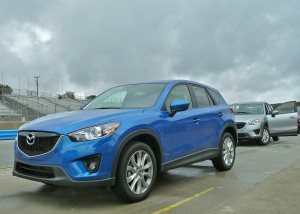
CX-5 styling strategy was done to encase Mazda's Skyactiv engine, drivetrain, aero and design technology.
By John Gilbert
Mazda has established a reputation for building vehicles that range from unusual to mainstream, with all of them sharing a heritage of being enjoyable to drive. With its new CX-5, Mazda may have outdone even its own standards — and the analogy of hitting a home run is noteworthy when nearly all competitors are settling for doubles and triples.
The CX-5 meets the demands of consumers in a struggling economy, who are seeking the seemingly impossible combination of efficient size, cutting-edge technology, safety, fun to drive performance and handling agility, high fuel-economy potential, and high-quality features, while still being available at a reasonable price. After a brief preliminary drive at its introduction, the CX-5 gave no hint of a weakness in any of those categories, all for a price structure starting at $21,000.
Skyactiv was impressive when first unveiled in the Mazda3 in October, although we were told at the time it had to be limited in its totally holistic application, because the full “spaghetti pile” of exhaust manifolds would not fit in the engine bay, and must wait for the next generation Mazda3. It was still an impressive jump, but now we learn the true difference. The CX-5 is the first of what Mazda calls its sixth generation of design concepts, and it was designed to be all-around Skyactiv to house the engine and transmission. The huge manifold fits under the hood, and it gains enough added torque to — suprisingly — outperform the smaller and lighter Mazda3.
Mazda introduced the CX-5 to the auto media at Monterey, Calif., so that we could drive it on Mazda Raceway at Laguna Seca. Driving an SUV, even a compact crossover SUV, on a famous road-racing circuit is a bold venture, but even in a steady rainstorm, the results were impressive. We were advised to stay off the fastest racing line, because the rain would make it slick, but after driving both the front-wheel and all-wheel-drive models for several turns, I felt confident enough to first go through the fast line at every turn, and then go hard through them all. The CX-5 never varied, never leaned, and never threatened to break traction.
It was so good that I asked a top Mazda performance engineer about the difference in lap time between the admittedly quick Mazda3 Skyactiv and the new CX-5 around the twisting Laguna track. He said the difference was 3 seconds — in favor of the CX-5! In road-racing, lap times are differentiated by tenths, and even hundredths, so a difference of 3 seconds a lap might cause the runner-up to withdraw.
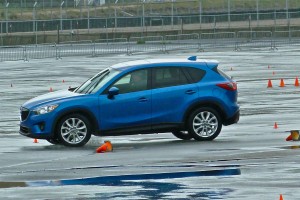
When pushed around a race track, or splashing around an autocross in the rain, the CX-5 was stable and firm.
We later pushed the CX-5s around a well-designed autocross course set up in the puddles of the paddock parking lot. Again, starting cautiously you realized you could take every turn faster, and confidence built quickly.
And this from a CX-5 that has highway fuel economy numbers ranging from 31-35 miles per gallon, depending on the model. My driving partner and I recorded a computerized 31.5 mpg on a stretch where my driving intentions were to evaluate the suspension and agility on the rolling hills and curving roadways inland from Monterey.
The shift from large SUVs to smaller and more fuel-efficient crossovers means manufacturers from all around the world are scurrying to improve their smallest SUVs to grab a slice of the expanding pie. A lot of outstanding vehicles crowd the compact crossover segment, but the common theme is compromise. In seeking more power, sportier handling, more comfortable suspension, interior amenities, safety, and improved real-world fuel-efficiency, providing “most of the above” is commendable. The Mazda CX-5 boasts “all of the above.”
The secret is not the CX-5’s design, or interior, or fun-to-drive suspension — although all of those elements are there — but the all-encompassing assets of Mazda’s new Skyactiv concept with its very impressive Skyactiv engine and purpose-built transmission. Read more
Fiat Abarth: ‘right amount of wrong’
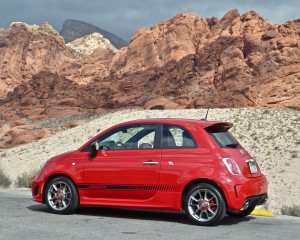
Stretched longer and housing power, suspension, interior and exterior upgrades, the Fiat Abarth costs $22,000.
By John Gilbert
Advertising can be coersive, exaggerated, informative, and meaningful, sometimes just annoying, other times fun. Then there are those special cases, where an ad can be so memorable it could only be improved if you could bring it to real life.
Fiat has pulled off one of those special ads, and it started with the Super Bowl and carried through to the introduction of the 2013 Fiat Abarth at the car’s introduction, in Las Vegas in early March. Fiat started to bring its subcompact 500 into the U.S. a year ago, and Jennifer Lopez did a series of memorable commercials driving the 500, but the little car drew some, but not a lot, of interest. Then came the Super Bowl.
The Fiat Abarth is a specially modified and turbocharged version of the new little subcompact 500 coupe, adding a new dimension to the 500 for Fiat, Italy’s expansive and technically savvy company, which now owns Chrysler Group. “The 500 is a fun, unique, agile, and cute car,” said Tim Kuniskis, the head of Fiat North America. “The Abarth is a 500 with just the right amount of wrong…It’s flirting with irrational, for $22,000.”
It’s not at all irrational if you thought the Fiat 500 needed a little extra dose of punch, because the Abarth has enough punch to satisfy discriminating performance-oriented drivers, whether on their daily commute, roaming on your favorite twisty roads, or taking advantage of a track-day at a local road-racing circuit. The question was, how to translate the special qualities of the Fiat Abarth, combining its practical side with its exotic Italian passionate heartbeat.
That made the Super Bowl the perfect launching pad for the Fiat Abarth, and it was a provocative ad that has continued, after turning out better than anyone could have imagined. The car comes in different colors, but because of the ad, you’ll have reason to picture it mainly in black.
As always, the Super Bowl was loaded with clever commercials, and sometimes they’re better than the actual football game. If you were normal — or at least a normal, red-blooded male — you undoubtedly remember the commercial where a normal-looking fellow is walking down a busy sidewalk, New York we’d guess, carrying a cappucino, or latte, or mocha, or some such designer coffee he has just purchased. Suddenly he stops in his tracks and stares, because ahead of him, bending over to adjust her high heels, is a stunningly beautiful, dark-haired woman in a provocatively flowing black dress with red trim. She glances back and catches him staring at her, and he freezes. She straightens up and confronts him, slaps him across the face, grabs him by the necktie and pulls him close to her. She reaches into his mocha-latte-cappucino thing and scoops out a fingerful of whipped cream. She puts it into her mouth, but a small bit of it falls, strategically plopping right where her discreetly plunging neckline is most discreet.
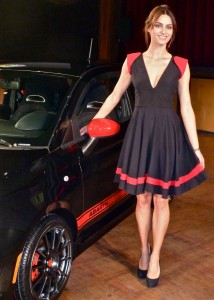
Catrinel Manghia repeated her prize-winning performance on Fiat Abarth TV ads at the Las Vegas media introduction. The car looked good, too.
The totally smitten guy is somewhere between shock and ecstacy, as he leans forward, slowly, eyes closed. We think he might attempt to lick up the fallen whipped cream, but as he leans forward, he opens his eyes to find that the most beautiful woman in the world has vanished. In place of his passionate objective is a new passionate objective — a Fiat Abarth, parked at the curb and wearing color-coordinated black paint with red accents.
When the seductive commercial first ran during the Super Bowl, Fiat’s website went instantly crazy. According to Edmunds.com, a widely accepted automotive news website, the Fiat showed an immediate increase of 3,354 percent in inquiries immediately after the Super Bowl ad aired — the largest increase of any of the many cars advertised during the game. Virtually all the hits were for the Fiat Abarth.
Since the Super Bowl, Fiat’s website has registered 8 million hits for the Abarth on Youtube, said Kuniskis, speaking at the news media introduction for the Fiat Abarth, in Las Vegas in early March. There have been more online requests for the Fiat Abarth since the Super Bowl than there had been, total, for the 500 itself in a full year. Read more
Toyota deserves an ‘A’ for new Prius c
By John Gilbert
For a couple of decades now, the entire Toyota auto empire has been identified by the Camry. But maybe it’s time to realize that the Prius might be taking over as Toyota’s new signature vehicle.
Actually, it’s not just the Prius anymore. It’s the whole Prius family, which has a new baby — the Prius c. The “c” is lower-case, incidentally, and allegedly stands for “city,” and it is projected to become the top-selling model in the Prius group, because it’s smaller, lighter, less expensive, and gets the best mileage of any Prius.
Those last two items are what Toyota figures will drop the company’s aging demographic and become the hybrid for the younger masses, because you can get into one and be environmentally sound for $20,000.
Toyota tends to go beyond single models, going instead for clusters of cars, such as Lexus, or Scion. The same has happened to the Prius, which started out over a decade ago as a single vehicle, and became the hybrid compact that outsells all other electric and/or hybrid vehicles combined. Only Honda, with its Civic Hybrid, has built a strong competitor in sales of a high-mileage, good-looking compact with a small gas engine complemented by a battery pack’s electric motor. With its gas engine hooked up to recharge the electric motor’s power, fuel economy numbers have commonly reached 40 miles per gallon and beyond.
The Prius came out in 2000 as a 2001 model, and the second generation moved the car from being an ugly duckling to a stylishly popular version with a contemporary angular look. The third generation refined the operation and carries on the look that carries on today. Toyota has sold 2.5 million Priuses globally, and 1.1 million of those have been in the U.S. That puts Prius at about a 4-1 advantage over Honda’s hybrids, 5-1 over Ford’s, and 10-1 over any hybrid sales generated by General Motors. Worries about the lifespan of the Toyota Hybrid Synergy Drive system have been nullified by the fact that 96 percent of all Priuses sold are still in operation.
Last year, Toyota expanded the Prius line by adding the Prius V, which is an elongated, wagon-style hatch companion to the standard Prius, which is now called the Hatchback. The Prius V adds 58 percent more cargo room, and Toyota sold 8,399 of them in their first 10 weeks on the market.
Obviously anticipating the arrival of the Chevrolet Volt and Nissan Leaf electric plug-in cars as competition, Toyota also added a plug-in version of the standard Prius Hatchback, which can be driven like a normal Prius, adding the advantage of plugging it in overnight. When fully charged, you can drive 15 miles at speeds up to 62 mph, and it will register 95 miles per gallon, or 50 in combined driving with both the plug-in charge and normal hybrid operation.
The Volt, incidentally, will run on electric only for about 35 miles, then its gas engine takes over, so if you live 10 miles from work you can get there and back day after day without ever needing to buy any more gasoline. However, the gas engine will not charge the battery pack, so it must be charged by overnight plug-in. The greater negative, along with a potential spike in your electric bill, is that the Prius price is in the $40,000 range, or about twice the price of a Prius c. Word came about the first of March that Chevrolet is halting production of the Volt for a few weeks because of more supply than demand.
There are four levels of Prius c vehicles, beginning with a base car at $18,950, a second level with more features at $19,900, then a step up to $21,635, and a fully loaded model at $23,230.
One of the key elements of the c is that it comes equipped with some impressive features. Traction control, stability control, brake assist, electronic brake force distribution, and a hill-start assist control to prevent rolling backwards, are among the features available. The modern trend is that if we’re moving toward smaller and more fuel-efficient cars, that doesn’t mean we want primitive and starkly basic cars. Read more
Hyundai renews Azera with FWD luxury
By John Gilbert
Remember the Hyundai Azera? It was a very nice and contemporary sedan, but it seemed to disappear from any promotional considerations because of the recent flurry of Hyundai’s high-style new vehicles. But that is about to change. The all-new and restyled Azera steps to the front of the class as perhaps the most dramatic example of Hyundai’s self-acclaimed “fluidic design.”
While a cut below Hyundai’s super-luxury Equus and the mid-luxury Genesis, the Azera is the company’s luxury front-wheel-drive car, just for those of us who live in area’s where winter driving is a challenge as well as a necessity. At the same time, Azera abandons being relegated to the list of “forgettable” nice cars, to command a prominent place on the “unforgettable” side of the ledger.
One of the reasons for the large pre-availability popularity of the Azera, which will hit showrooms in mid-March, is that it was a star of Hyundai’s advertising strategy to engulf recent television extravaganzas like the Grammys and Academy Awards. The Azera commercials were so good many viewers might remember them better than Adele, Taylor Swift, Meryl Streep, or “The Artist.”
The Azera’s splashy introduction came just in time, too, because it will show up at dealerships just after the Upper Midwest suddenly decided to have winter, after all. There’s nothing like a foot or two of snow to snap drivers back into the reality of the advantages of front-wheel drive. Rear-drive advocates rave about the highly sophisticated new traction-control systems that make rear-drive cars more capable in winter conditions, but the same applications work on front-wheel-drive too, and further the inherent advantages FWD starts out with in conquering slippery driving challenges. Read more
BMW 3-Series dazzles at introduction
By John Gilbert
MONTEREY, CALIF. — All is fair in love, war, and new car introductions, apparently. But if it’s BMW, some things seem unfair. BMW summoned North American auto writers for first test-drives of the sixth generation BMW 3 Series. We knew going in we were going to be driving the latest iteration of a sedan that every other car maker identifies as the benchmark they used for any new vehicle.
First impression shows a refined kidney-shaped grille, with headlights that are stretched horizontally, enclosed in an elongated housing that reaches from the outer edges to the grille, and they are overlined with a sloping line that changes the personality of the car. BMWs always have looked a little bit like raptors, face on, and the new 3 looks more like an extra-aggressive and maybe hungry raptor on the prowl, capable of diving and pouncing on its prey from wherever it chooses.
It looks larger because it is, and its power now comes from a pair of highly refined turbocharged engines — either a 2.0-liter 4-cylinder, giving the 328 model 240 horsepower at 5,000 RPMs and 260 foot-pounds of torque at a mere 1,250 RPMs, or the familiar 3.0-liter in-line 6, with 300 horsepower at 5,800 RPMs and 300 foot-pounds of torque holding that peak from 1,250 to 5,000 RPMs. A 6-speed manual or 8-speed automatic — smooth-shifting, but not a direct-sequential twin-clutch device — which can be upgraded to a sport package with steering wheel paddles to manually make or hold shifts. The smooth abundance of power indicates BMW has maintained its perch at the top of my personal rating of auto-world technology.
There are three trim groupings, with the Sport Line identifiable by 8 high-gloss black vertical bars in its grille, the Luxury Line with 11 chrome bars, and the Modern Line with 11 satin-silver bars. There are more exceptions than models, however, because you can get the 4 or the 6 in any version, and you can upgrade to sport application if desired. Also, a wagon version is coming, and so are a hybrid, a pure-electric version, and the highest-performing M3, all of which should be showing up by the end of summer. There will be no diesel for the 2012 calendar year.
Prices provoke my old axiom for BMW. The 328i with the 4 starts at $35,795, and the 335i with the 6 starts at $43,295. My axiom about the cost of a BMW: “Exorbitantly priced, but worth every penny.” Read more


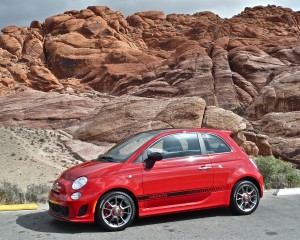
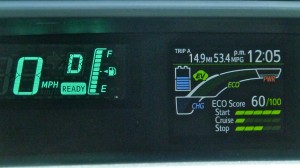
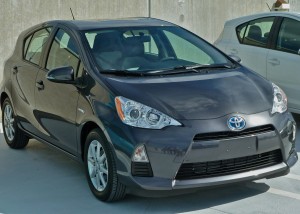
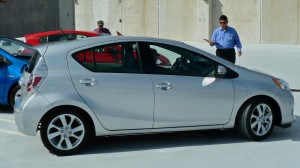
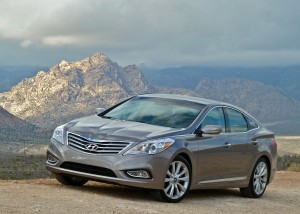
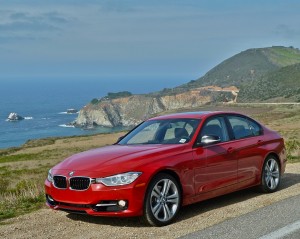
 John Gilbert is a lifetime Minnesotan and career journalist, specializing in cars and sports during and since spending 30 years at the Minneapolis Tribune, now the Star Tribune. More recently, he has continued translating the high-tech world of autos and sharing his passionate insights as a freelance writer/photographer/broadcaster. A member of the prestigious North American Car and Truck of the Year jury since 1993. John can be heard Monday-Friday from 9-11am on 610 KDAL(www.kdal610.com) on the "John Gilbert Show," and writes a column in the Duluth Reader.
John Gilbert is a lifetime Minnesotan and career journalist, specializing in cars and sports during and since spending 30 years at the Minneapolis Tribune, now the Star Tribune. More recently, he has continued translating the high-tech world of autos and sharing his passionate insights as a freelance writer/photographer/broadcaster. A member of the prestigious North American Car and Truck of the Year jury since 1993. John can be heard Monday-Friday from 9-11am on 610 KDAL(www.kdal610.com) on the "John Gilbert Show," and writes a column in the Duluth Reader.